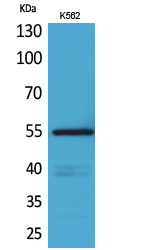产品名称
CD55 Rabbit Polyclonal Antibody
别名
CD55; CR; DAF; Complement decay-accelerating factor; CD55
蛋白名称
Complement decay-accelerating factor
存储缓冲液
Liquid in PBS containing 50% glycerol, 0.5% BSA and 0.02% New type preservative N.
Human Gene Link
http://www.ncbi.nlm.nih.gov/sites/entrez?db=gene&term=1604
Human Swissprot No.
P08174
Human Swissprot Link
http://www.uniprot.org/uniprotkb/P08174/entry
免疫原
The antiserum was produced against synthesized peptide derived from the Internal region of human CD55. AA range:241-290
特异性
CD55 Polyclonal Antibody detects endogenous levels of CD55 protein.
稀释度
WB 1:500 - 1:2000. ELISA: 1:20000. Not yet tested in other applications.
宿主
Polyclonal, Rabbit,IgG
背景介绍
This gene encodes a glycoprotein involved in the regulation of the complement cascade. Binding of the encoded protein to complement proteins accelerates their decay, thereby disrupting the cascade and preventing damage to host cells. Antigens present on this protein constitute the Cromer blood group system (CROM). Alternative splicing results in multiple transcript variants. The predominant transcript variant encodes a membrane-bound protein, but alternatively spliced transcripts may produce soluble proteins. [provided by RefSeq, Jul 2014],
组织表达
Expressed on the plasma membranes of all cell types that are in intimate contact with plasma complement proteins. It is also found on the surfaces of epithelial cells lining extracellular compartments, and variants of the molecule are present in body fluids and in extracellular matrix.
细胞定位
[Isoform 1]: Cell membrane; Single-pass type I membrane protein.; [Isoform 2]: Cell membrane; Lipid-anchor, GPI-anchor.; [Isoform 3]: Secreted .; [Isoform 4]: Secreted .; [Isoform 5]: Secreted .; [Isoform 6]: Cell membrane ; Lipid-anchor, GPI-anchor .; [Isoform 7]: Cell membrane ; Lipid-anchor, GPI-anchor .
信号通路
Complement and coagulation cascades;Hematopoietic cell lineage;Viral myocarditis;
功能
domain:The first Sushi domain (SCR1) is not necessary for function. SCR2 and SCR4 provide the proper conformation for the active site on SCR3.,function:This protein recognizes C4b and C3b fragments that condense with cell-surface hydroxyl or amino groups when nascent C4b and C3b are locally generated during C4 and c3 activation. Interaction of daf with cell-associated C4b and C3b polypeptides interferes with their ability to catalyze the conversion of C2 and factor B to enzymatically active C2a and Bb and thereby prevents the formation of C4b2a and C3bBb, the amplification convertases of the complement cascade.,online information:Blood group antigen gene mutation database,online information:CD55 mutation db,online information:Decay-accelerating factor entry,online information:Icosahedral capsid structure,polymorphism:Responsible for the Cromer blood group system. It consists of at least 8 high-incidence (Cr(a), Tc(a), Dr(a), Es(a), WES(b), UMC, IFC and GUTI) and three low-incidence (Tc(b), Tc(c) and WES(a)) antigens that reside on DAF. In the Cromer phenotypes Dr(a-) and Inab there is reduced or absent expression of DAF, respectively. In the case of the Dr(a-) phenotype, a single nucleotide substitution within exon 5 accounts for two changes: a simple amino acid substitution, Leu-199 that is the basis of the antigenic variation, and an alternative splicing event that underlies the decreased expression of DAF in this phenotype. The Inab phenotype is a very rare one in which the red blood cells lack all Cromer system antigens. The red blood cells of individuals with Inab phenotype have a deficiency of DAF, but these individuals are not known to have any associated hematologic or other abnormalities.,PTM:The Ser/Thr-rich domain is heavily O-glycosylated.,similarity:Belongs to the receptors of complement activation (RCA) family.,similarity:Contains 4 Sushi (CCP/SCR) domains.,subunit:Monomer (major form) and non-disulfide-linked, covalent homodimer (minor form). Binds to coxsackievirus A21, coxsackieviruses B1, B3 and B5, human enterovirus 70, human echoviruses 6, 7, 11, 12, 20 and 21 capsid proteins and acts as a receptor for these viruses.,tissue specificity:Expressed on the plasma membranes of all cell types that are in intimate contact with plasma complement proteins. It is also found on the surfaces of epithelial cells lining extracellular compartments, and variants of the molecule are present in body fluids and in extracellular matrix.,
纯化
The antibody was affinity-purified from rabbit antiserum by affinity-chromatography using epitope-specific immunogen.


